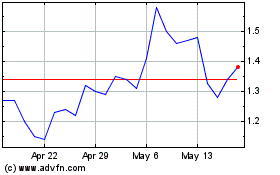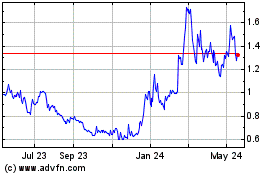Passage Bio Presents Preclinical and Interim Clinical Data for PBFT02 in FTD-GRN at the European Society of Gene & Cell Therapy (ESGCT) 31st Annual Conference
24 October 2024 - 10:00PM

Passage Bio, Inc. (Nasdaq: PASG), a clinical stage genetic
medicines company focused on improving the lives of patients with
neurodegenerative diseases, today announced the company delivered
preclinical and interim clinical data as part of an oral
presentation at the European Society of Gene & Cell Therapy
(ESGCT) 31st Annual Congress being held October 22-25, 2024, in
Rome, Italy.
Details of the oral presentation are below:
| Abstract
Title: |
Non-clinical and early clinical development of PBFT02, an AAV gene
therapy for frontotemporal dementia with GRN mutations
(FTD-GRN) |
| Session: |
7d: CNS gene therapy |
| Date &
Time: |
Thursday, October 24 from 9:00 a.m.-11:00 a.m. CEST (3:00 a.m.-5:00
a.m. ET) |
| Presenter: |
Sue Browne, Ph.D., Chief Scientific Officer |
Today's oral presentation at ESGCT outlined the robust
preclinical data generated in the development of PBFT02, including
studies that informed vector and dose selection and demonstrated
the positive effects of elevating progranulin levels in vivo.
Additionally, the presentation highlighted interim safety and
biomarker data from the upliFT-D clinical trial, which validate the
preclinical findings and position PBFT02 as a potential
best-in-class progranulin-raising therapy.
“We are excited to share a detailed overview of the preclinical
studies that support our PBFT02 program and informed our clinical
development strategy,” said Will Chou, M.D., president and chief
executive officer of Passage Bio. “These strong preclinical results
gave us confidence in choosing the AAV1 vector and ICM
administration as a differentiated approach to administer our gene
therapy to patients in our ongoing upliFT-D clinical study. It’s
also encouraging to see these preclinical findings translate into
the clinic, with interim PBFT02 data demonstrating a well-tolerated
safety profile and consistent, durable increases in CSF progranulin
levels. We remain committed to advancing PBFT02 in FTD and look
forward to exploring its therapeutic potential in additional
neurodegenerative diseases that could benefit from elevated
progranulin levels.”
Data Summary
- Capsid comparison study in non-human primates (NHPs) showed the
AAV1 vector achieved superior human PGRN levels in the CSF as
compared to AAV5 and AAVhu68 (an AAV9 variant) following
intra-cisterna magna (ICM) administration
- Dose escalation study in Grn knockout mice showed PBFT02
improved lysosomal histopathology and reduced neuroinflammation
throughout the brain following intra-CSF delivery, including
evidence suggesting that higher levels of PGRN may provide
additional benefits
- NHP biodistribution study showed ICM administration of PBFT02
achieved high levels of gene distribution throughout the nervous
system, including vector delivery to the cortical and sub-cortical
brain regions affected in FTD, and to the spinal cord
- PBFT02 was well tolerated in NHPs, and ICM administration
resulted in dose-dependent PGRN elevations in NHP CSF
- Interim safety and biomarker data from the upliFT-D clinical
study demonstrated that Dose 1 of PBFT02 was generally
well-tolerated after ICM administration and led to consistent,
durable increases in levels of CSF progranulin in all treated
Cohort 1 patients, with elevated CSF progranulin levels sustained
up to 12 months post-administration
Additional details on the meeting can be found at the ESGCT
31st Annual Congress website, and a copy of the oral
presentation deck will be available on the Investor Events and
Presentations page of the Passage Bio corporate website.
About PBFT02
PBFT02 utilizes an AAV1 viral vector to deliver, through ICM
administration, a functional GRN gene that encodes for
PGRN. This vector construct and delivery approach aim to elevate
PGRN levels in the central nervous system to alter the course of
neurodegenerative diseases. Interim clinical data from the upliFT-D
Phase 1/2 study in FTD-GRN participants shows that ICM
administration of PBFT02 resulted in robust PGRN elevations in the
CSF.
The potential clinical benefit of PBFT02 is supported by
extensive preclinical studies. In non-human primates, a single ICM
administration of PBFT02 led to broad vector distribution
throughout the CNS, and robust, dose-dependent elevations in PGRN
levels in CSF. An NHP study also demonstrated that AAV1 was
particularly proficient at transducing ependymal cells. In a murine
FTD model, PBFT02 administration improved lysosomal function and
reduced neuroinflammation.
About Passage Bio
Passage Bio (Nasdaq: PASG) is a clinical stage genetic medicines
company on a mission to improve the lives of patients with
neurodegenerative diseases. Our primary focus is the development
and advancement of cutting-edge, one-time therapies designed to
target the underlying pathology of these conditions. Passage Bio’s
lead product candidate, PBFT02, seeks to treat neurodegenerative
conditions, including frontotemporal dementia, by elevating
progranulin levels to restore lysosomal function and slow disease
progression.
To learn more about Passage Bio and our steadfast commitment to
protecting patients and families against loss in neurodegenerative
conditions, please visit: www.passagebio.com.
Forward-Looking Statements
This press release contains “forward-looking statements” within
the meaning of, and made pursuant to the safe harbor provisions of,
the Private Securities Litigation Reform Act of 1995, including,
but not limited to: our expectations about timing and execution of
anticipated milestones, including the progress of clinical studies
and the availability of clinical data from such trials; our
expectations about our collaborators’ and partners’ ability to
execute key initiatives; and the ability of our product candidates
to treat their respective target CNS disorders. These
forward-looking statements may be accompanied by such words as
“aim,” “anticipate,” “believe,” “could,” “estimate,” “expect,”
“forecast,” “goal,” “intend,” “may,” “might,” “plan,” “potential,”
“possible,” “will,” “would,” and other words and terms of similar
meaning. These statements involve risks and uncertainties that
could cause actual results to differ materially from those
reflected in such statements, including: our ability to develop and
obtain regulatory approval for our product candidates; the timing
and results of preclinical studies and clinical trials; risks
associated with clinical trials, including our ability to
adequately manage clinical activities, unexpected concerns that may
arise from additional data or analysis obtained during clinical
trials, regulatory authorities may require additional information
or further studies, or may fail to approve or may delay approval of
our drug candidates; the occurrence of adverse safety events; the
risk that positive results in a preclinical study or clinical trial
may not be replicated in subsequent trials or success in early
stage clinical trials may not be predictive of results in later
stage clinical trials; failure to protect and enforce our
intellectual property, and other proprietary rights; our dependence
on collaborators and other third parties for the development and
manufacture of product candidates and other aspects of our
business, which are outside of our full control; risks associated
with current and potential delays, work stoppages, or supply chain
disruptions; and the other risks and uncertainties that are
described in the Risk Factors section in documents the company
files from time to time with the Securities and Exchange Commission
(SEC), and other reports as filed with the SEC. Passage Bio
undertakes no obligation to publicly update any forward-looking
statement, whether written or oral, that may be made from time to
time, whether as a result of new information, future developments
or otherwise.
For further information, please contact:
Investors: Stuart Henderson Passage Bio
267.866.0114 shenderson@passagebio.com
Media:Mike BeyerSam Brown Inc. Healthcare
Communications312.961.2502MikeBeyer@sambrown.com
Passage Bio (NASDAQ:PASG)
Historical Stock Chart
From Oct 2024 to Nov 2024

Passage Bio (NASDAQ:PASG)
Historical Stock Chart
From Nov 2023 to Nov 2024
